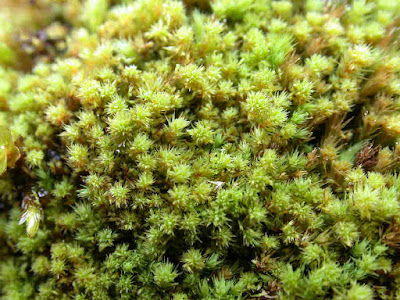 Isopterygium albescens, from Hong Kong Flora.
Belongs within: Hypnales
Isopterygium albescens, from Hong Kong Flora.
Belongs within: Hypnales.
Isopterygium is a genus of mosses found around the world, primarily in terrestrial habitats. They are characterised by the possession of filamentous pseudoparaphyllia.
Characteristics (from Ireland & Buck 2009): Plants small to medium-sized, in thin to dense mats, glossy, light green to yellow-green. Stems complanate-foliate, creeping, simple or sparingly and irregularly branched, cortical cells small and thick-walled in cross-section, surrounding larger, thinner walled cells, central strand usually absent; rhizoids smooth, on ventral surface of stems and branches just below juncture of leaves; filamentous pseudoparaphyllia present, of 3–6 cells in 1 row or rarely 2 rows near base; axillary hairs consisting of 1 moderately long, brown basal cell and 1–3 elongate, hyaline distal cells. Asexual reproductive bodies sometimes present on stems and branches, uniseriate, often branched, filamentous, multicellular bodies with papillose cells. Stem and branch leaves similar, rigid or flaccid, crowded and imbricate to remote, erect-spreading or squarrose, sometimes contorted when dry, smooth, flat or somewhat concave, symmetric or asymmetric, nondecurrent or rarely with 1–2 decurrent cells, ovate or lanceolate, sometimes oblong, acute to acuminate; margins plane to erect, sometimes recurved at base, serrulate above the middle, mostly entire below, sometimes entire throughout; costa short and double, occasionally lacking; median cells often flexuose, thin to firm-walled, linear-fusiform, smooth, with walls not pitted or occasionally those of basal cells pitted; alar cells usually clearly differentiated, quadrate to rectangular, rarely transversely elongate. Autoicous or rarely dioicous; perigonia scattered along the stems; perichaetia at base of stems, leaves oblong-lanceolate, gradually acuminate; margins plane. Setae smooth, elongate, straight to curved, usually twisted, yellow, brown, or reddish brown; capsules inclined to cernuous, or sometimes erect, straight or curved when mature, brown to red-brown, cylindrical, ellipsoid or ovoid, smooth or sometimes wrinkled at neck and usually contracted below the mouth when dry; operculum conic to short-rostrate, shorter than the urn; annulus none; peristome double, exostome teeth cross-striolate below, papillose above, bordered, trabeculate at back; endostome with a high to low basal membrane, keeled segments, and cilia shorter than the segments, in groups of 1–3, sometimes absent. Spores spherical to ovoid, smooth or minutely papillose. Calyptra cucullate, smooth, naked.
<==Isopterygium Mitt. 1869 SK02
|--I. acuminatum Bosw. 1892 SK02
|--I. albescens (Hooker) Jaeger 1878 [incl. Hypnum candidum, I. candidum; incl. I. molliculum] SK02
|--I. amblyocarpum (Hampe) Broth. 1908 [=Leskea amblyocarpa, Platygyrium amblyocarpum] SK02
|--I. amoenum Broth. 1900 SK02
|--I. arachnoideum Broth. 1900 SK02
|--I. byssicaule (Müll.Hal.) Jaeger 1878 SK02
|--I. howeanum Broth. & Watts 1915 SK02
|--I. latifolium Broth. 1900 SK02
|--I. lignicola N02
|--I. limatum (Hooker & Wilson) Broth. 1908 (see below for synonymy) SK02
|--I. longitheca N02
|--I. minutirameum (Müll.Hal.) Jaeger 1878 [=Taxiphyllum minutirameum (Müll.Hal.) Mill. & Smith 1968] SK02
| |--I. m. var. minutirameum [incl. Hypnum austropusillum, I. austropusillum] SK02
| `--I. m. var. brevifolium (Fleischer) Bartram 1933 (see below for synonymy) SK02
|--I. neocaledonicum Thér. 1909 SK02
|--I. norfolkianum SK02 (see below for synonymy)
|--I. novae-valesiae Broth. 1900 [=Taxithelium novae-valesiae (Broth.) Broth. 1908] SK02
|--I. pseudosubulatum SK02
|--I. pulchellum (Hedw.) Jaeger 1878 SK02 (see below for synonymy)
`--I. subarachnoideum Broth. 1900 SK02
Nomina nuda: Isopterygium austrosubulatum Müll.Hal. ex Burges 1935 SK02
Isopterygium baileyanum Müll.Hal. ex Bailey 1888 SK02
Isopterygium caespitulosum Paris 1900 [=Taxicaulis caespitulosus Müll.Hal. ex Paris 1900] SK02
Isopterygium sublatifolium Broth. 1918 SK02
Isopterygium viridepallens Müll.Hal. ex Burges 1935 SK02
Isopterygium viridipallidus Müll.Hal. ex Forsyth 1900 SK02
Isopterygium limatum (Hooker & Wilson) Broth. 1908 [=Hypnum limatum, Rhaphidorrhynchum limatum (nom. inv.); incl. Ectropothecium australe] SK02
Isopterygium minutirameum var. brevifolium (Fleischer) Bartram 1933 [=Taxiphyllum minutirameum var. brevifolium (Fleischer) Whittier 1975] SK02
Isopterygium norfolkianum SK02 [=Hypnum norfolkianum SK02; incl. H. nitidulum (nom. illeg.) SK02, Isopterygium pulchellum var. nitidulum D24, Plagiothecium pulchellum var. nitidulum D24]
Isopterygium pulchellum (Hedw.) Jaeger 1878 SK02 [=Hypnum pulchellum D24, Isopterygiopsis pulchella SK02, Plagiothecium pulchellum D24]
*Type species of generic name indicated
REFERENCES
[D24] Dixon, H. N. 1924.
The Student's Handbook of British Mosses 3
rd ed. V. V. Sumfield: Eastbourne.
Ireland, R. R., & W. R. Buck. 2009. Some Latin American genera of Hypnaceae (Musci).
Smithsonian Contributions to Botany 93: 1-97.
[N02] Negi, H. R. 2002. Abundance and diversity of moss communities of Chopta-Tunganath in the Garhwal Himalaya.
Journal of the Bombay Natural History Society 99 (3): 418–433.
[SK02] Streimann, H., & N. Klazenga. 2002.
Catalogue of Australian Mosses.
Flora of Australia Supplementary Series 17. Australian Biological Resources Study: Canberra.
Last updated: 9 January 2018.











